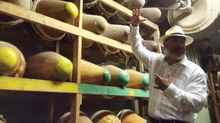Reshoring: Q&A Analysis of Intangibles on Returning Production, Sourcing to the US

North America’s $137 billion metalforming industry is driven by the production of a myriad of precision metal products using stamping, fabricating, spinning, slide forming, and roll forming technologies, as well as vital value-added processes. In recent decades, approximately three to four million of all US manufacturing jobs have been cumulatively lost to offshoring.
The tide seems to be turning modestly in recent years by companies returning US production or sourcing from offshore. In comparison to 2000-2003, when the US lost (net) about 220,000 manufacturing jobs per year to offshoring, 2016 achieved a net gain of 27,000.
Progressively bridging this gap presents huge collaborative opportunities and challenges to all associated manufacturers, associations, employees, communities, and the US government itself.
Participating in this Q&A about bringing back production or sourcing back to the US is John Stoneback, president of JM Performance Products Inc., Fairport Harbor, (OH), and Harry Moser, president of the Reshoring Initiative (RI), a nonprofit organization, Kildeer, (IL).
Q: What are the key variables that have driven/drive domestic manufacturing overseas?
Harry Moser: When they first began to offshore, say, to China, the Chinese wages were so low that the price differential was 30 or 40 percent. But now that the Chinese wages have come up, that price gap might only be 10 or 15 percent. As a result, even China is outsourcing to Malaysia for cheaper labor.
Additionally, the current USD is 30% too high vs. other currencies. Corporate tax rates are too high, there’s no Value-Added Tax (VAT), too many regulations, healthcare costs are too high, oil prices are low, and there’s a weak skilled workforce. We’ll need stronger innovation and some confidence that the current administration will overcome some of these negatives, so the price gap will shrink enough that companies will start to see that the hidden costs of offshoring close the deal.

John Stoneback: US productivity is two to three times that of the Chinese, so the key is to have the benefit of the advantages of reshoring be enough to overcome the remaining labor cost gap. Ultimately at first glance, overseas is a low part cost benefit. Overcoming the shrinking emerging market wage advantages via factoring in all the intangibles makes reshoring a different story.
Q: What are the key variables that can currently encourage domestic manufacturing to reshore?
John Stoneback: The simple fact is that there are always three key benefits in reshoring: cost, time, and insurance. Maybe even a fourth: factor inventory and space logistics. Those factors are so small to consider if you’re manufacturing in the US, that you can do the math in your head as it’s a simple cost analysis.
Basically, there’s more control as the ability to guarantee delivery within five days or so, even by truck, anywhere in the US is reasonable, therefore it’s easier to keep the supply going smoothly without any overseas delays or surprises. Even the weather is a factor in delivering from overseas. In the simplest terms, you can anticipate approximately four to five times shipping cost variance in bringing products in from China vs. the US. That’s not even factoring in the importer’s mark-up on products from overseas, which could be upwards of 15 cents on the USD.
Harry Moser: There are advantages of building dies in the US to manufacture components and we should be focused on bringing them back. Factors such as duty, freight costs, tied-up cash flow, poor product quality, intellectual property risk, and delayed delivery are all reduced. There also would be the value-added benefits of ease of attending run-off, ability to send the die back quickly for correction, spare parts availability, and ease of partnering with the customer, amongst others.
Q: What are the key short/long term variables that can promote a domestic manufacturing renaissance?
Harry Moser: Nationally and corporation wise, we need a more highly skilled workforce, advanced basic education, and improved automation. By promoting partnerships with Skilled Workforce and Economic Development Programs, embracing US companies with reshoring-focused technologies, and the use of the Reshoring Initiative’s Total Cost of Ownership Estimator, we can collectively make reshoring a more viable short and long-term platform for more orders, jobs, and profitability.

John Stoneback: In today’s offshoring climate, we’re left with more short order production runs. We need to train our workforce so they can handle the capacity of the jobs that are big in volume that can create long-term employment. Plants overseas use less and less people and more robotics—we need to train people so they are skilled craftsmen again.
Education is a factor, approximately 1/3 less training is required for a CNC milling person with high torque retention knobs. Additionally, there is no variance with our product as you set up the job once and use them the same way identically, so there’s no additional set-up time. In fact, a single operator can run at least one additional milling machine (upwards to a max of four) once the work piece is set, you just press a button on the machine. Imagine the production savings in that equation in reducing cycle times, labor costs, and delivery time—all while improving quality and surface finish.
Q: What does the future climate hold for advancing this reshoring renaissance?
Harry Moser: Reshoring is showing incremental strength across the board in leading industries such as transportation, equipment, appliances, plastic and rubber products, fabricated metal products, electronics, and apparel. If reshoring continues to progress in the long term, it will help eliminate the $500 billion trade deficit, avoid the collapse of the USD, cut the budget deficit in half, strengthen recruitment of skilled workforce, stabilize the military industrial base, fix income inequality, and enhance innovation.
John Stoneback: For companies with unique technologies such as ours, it’s as simple as converting existing CNC systems to the new knobs to immediately reduce manufacturing costs, and educating people how to do setups and working the parts. Ultimately, less training and less tooling—everything is a plus as a 10-30% overall productivity increase is a realistic and achievable goal.
With high torque retention knobs you start subtracting 20% on time, tooling costs, education, job set-up, and there’s no maintenance. Any product that requires a lot of people to make is going to be desired by all sides, and we need more of these high-volume production jobs reshored.
Q: How can your entities collective analytical tools help manufacturers quantify the hidden costs of offshoring vs. reshoring?
Harry Moser: Most companies make sourcing decisions based solely on price, oftentimes resulting in a 20-to-30 percent miscalculation of actual offshoring costs. The TCO Estimator is a free online tool that helps companies account for all relevant factors—overhead, balance sheet, risks, corporate strategy and other external and internal business considerations—to determine the true total cost of ownership. By leveraging this information, companies can better evaluate sourcing, identify alternatives, and even make a case when selling against offshore competitors.
John Stoneback: Typical CNC milling centers are running machines 20-40% slower than they should be. If you are able to significantly increase the speed of machines via eliminating the deficiencies of conventional retention knobs vs. JMPP High Torque Retention Knobs, conservative estimate savings of 10-15% can be achieved.
We offer customers a free analytical conversion consultation based on ROI in using our product, which can assist them in determining overall production savings in manufacturing. It starts with a simple equation—at a conservative minimum of 10% productivity increase using our High Torque Retention Knobs vs. convention knobs, how would it affect the health of your company?






















